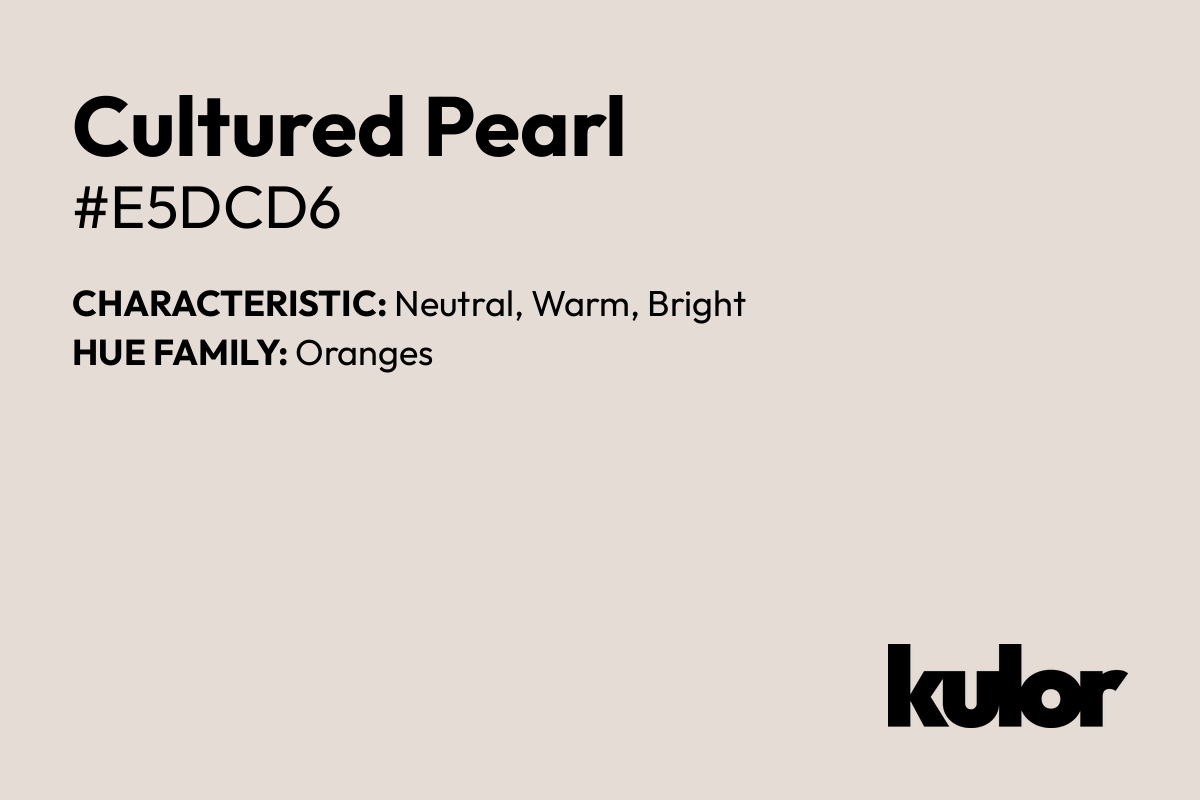Color Cultured Pearl red-orange (#e5dcd6):
HEX, RGB color codes for HTML and CSS
The Comprehensive Guide to Cultured Pearl red-orange (#e5dcd6):
Its Meaning and Harmonious Color Matches in Design.

Hue Family:
red-oranges
red-oranges Family:
light-muted
Saturation:
almost gray
Tones:
light-toned
Shade:
light
Temperature:
warm
Chromaticity:
near-grayscale
Chroma:
low chroma
Color Information about Cultured Pearl / #e5dcd6
The HTML HEX code is #e5dcd6. The corresponding color name is "Cultured Pearl". In RGB values (additive color space used for Digital Displays), this HEX code translates to Red (R): 229%, Green (G): 220%, Blue (B): 214%. In the CMYK color model (subtractive color model used in printing), it is represented by Cyan (C): 0%, Magenta (M): 4%, Yellow (Y):7%, Black (K): 10%. In the HSL color space, #e5dcd6 has a hue of 24°, saturation of 22%, and lightness of 87%. The HSV representation is 24° for hue, 7% for saturation, and 90% for value.
In the CIE-LAB color space, the color is denoted by L* (lightness) = 88, a* (green to red) = 2, and b* (blue to yellow) = 4. The XYZ representation is X: 70, Y: 73, Z: 74. In the YUV color space, it translates to Y (luminance) = 0.8706, U (chrominance) = -0.0154, and V (chrominance) = 0.0241.
The decimal value of the color is 15064278. The closest Web-safe HEX code is #CCCCCC. Variations of the colour are #FFFFFF for a 20% lighter version and #BDA798 for a 20% darker version.
For the color with hex value #e5dcd6, the correlated color temperature (CT) is estimated to be 5932 Kelvin (5932K).
The approximate wavelength of #e5dcd6 is around 652.00nm.
| VALUE | CSS | |
|---|---|---|
| HEX Code | e5dcd6 | #e5dcd6 |
| RGB Decimal Code | 229, 220, 214 | rgb(229, 220, 214) |
| CMYK | 0, 4, 7, 10 | / |
| HSL | 24°, 22%, 87% | hsl(24°, 22%, 87%) |
| HSV | 24°, 7%, 90% | / |
| CIE-LAB | 88, 2, 4 | / |
| XYZ | 70, 73, 74 | / |
| YUV | 0.8706, -0.0154, 0.0241 | / |
| Decimal value | 15064278 | / |
| Web-Safe HEX | CCCCCC | #CCCCCC |
| Color Temperature (CT) | 5932 Kelvin (5932K) | / |
| Estimate Wavelength | around 652.00nm | / |
The Depth and Diversity of Cultured Pearl (Hex: #e5dcd6): Exploring its Impact in Design and Culture
The hex color #e5dcd6, named Cultured Pearl, resembles the soft and soothing tone of a seashell found on a sandy beach. This color exudes elegance and sophistication, much like the smooth surface of a polished pearl. It evokes a sense of purity and simplicity, similar to the subtle beauty of freshly fallen snow or the delicate petals of a white lily. Cultured Pearl is a versatile color that can be used to create a tranquil and serene ambiance, making it a popular choice for home decor, wedding themes, and luxurious branding.
Download Stunning Cultured Pearl Wallpapers and Backgrounds
Enhance your devices with our minimalistic yet captivating Cultured Pearl Wallpapers, perfectly designed for 4K, 5K, iPhone, and Android screens. Experience a unique aesthetic that brings elegance to your digital life.
Experience Elegance with Cultured Pearl 4K Wallpaper
Immerse yourself in the beauty of our Cultured Pearl 4K Wallpaper, offering a resolution of 3840px by 2160px. Perfect for high-resolution displays, this wallpaper brings a touch of sophistication to your desktop.
Download Cultured Pearl 4K WallpaperTints and Shades of #e5dcd6 HEX color (Cultured Pearl)
In color theory, tints and shades are essential for understanding the depth and luminosity of colors. A tint is achieved by adding white to a pure hue, lightening its appearance. Conversely, a shade results from blending black with a color, giving it a deeper tone. In the context of #e5dcd6, this color stands at the center between its tints and shades. While the tints get progressively lighter moving towards white (#ffffff), the shades deepen towards black (#000000).
- #ffffff
- #F9F6F5
- #F2EEEB
- #ECE5E0
- #e5dcd6
- #ACA5A1
- #736E6B
- #393736
- #000000
Tones of Cultured Pearl (#e5dcd6 HEX color)
A tone is produced by adding gray to any pure hue. In the case of #e5dcd6, #bdb7b4 is the less saturated color, while #e5dcd6 is the most saturated one.
- #bdb7b4
- #c7c0bc
- #d1cac5
- #dbd3cd
- #e5dcd6
- #8b786b
- #8d7668
- #8e7564
- #907361
HTML Usage Examples
HTML using color code example
<p style="color: #e5dcd6;">This is a css example</p>HTML / CSS Color Name using W3C
W3C HTML / CSS Color Name doesn't exist for #e5dcd6.
CSS color code example
p { color: #e5dcd6; }Text with hexadecimal color #e5dcd6
This is a sample text with color #e5dcd6.
Background Color with #e5dcd6
This is a example with background color #e5dcd6.
Border Color with #e5dcd6
#e5dcd6 Color Preview on White (#ffffff) Background
This is a example of text with color #e5dcd6 on white background.
#e5dcd6 Color Preview on Black (#000000) Background
This is a example of text with color #e5dcd6 on black background.
CSS codes examples
.text {color:#e5dcd6;}.background {background-color:#e5dcd6;}.border {border:1px solid #e5dcd6;}